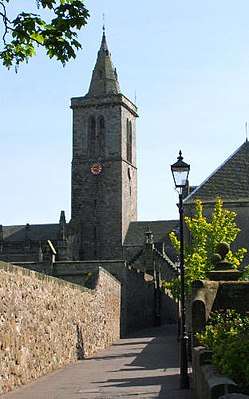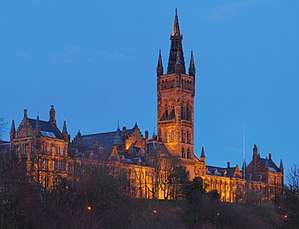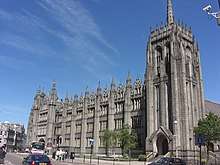Ancient universities of Scotland
The ancient universities of Scotland (Scottish Gaelic: Oilthighean ann an Alba)[1] are medieval and renaissance universities which continue to exist in the present day. The majority of the ancient universities of the British Isles are located within Scotland, and have a number of distinctive features in common, being governed by a series of measures laid down in the Universities (Scotland) Acts 1858–1966. The Universities (Scotland) Act 1966 uses the term 'older universities' to refer to St Andrews, Glasgow, Aberdeen and Edinburgh.[2] The same act provided for the independence from St Andrews of Dundee, which was then granted a similar form of governance under its royal charter.
In common with the other ancient universities of the United Kingdom, the Scottish ancients find themselves administered in a quite different fashion from these new universities (of which there are now fifteen in Scotland) and are granted a number of privileges as a result of their different status.
Background
Following the creation of the ancient universities before the end of the 16th century, no other universities were formed in Scotland until the twentieth century. The first 'new university' of the era was the University of Strathclyde which received its royal charter in 1964, although it traces its origins back to the Andersonian Institute (also known at various times as Anderson's College and Anderson's University) founded in 1796.[3][4][5][6]
Members
Most sources cite four ancient universities of Scotland which are, in order of foundation:
- University of St Andrews – founded 1413
- University of Glasgow – founded 1451
- University of Aberdeen – founded 1495 (see below)
- University of Edinburgh – founded 1583
St Andrews

The University of St Andrews owed its origin to a society formed in 1410 by Laurence of Lindores, archdeacon Richard Cornwall, bishop William Stephenson and others. Bishop Henry Wardlaw (died 1440) issued a charter in 1411 and attracted the most learned men in Scotland as professors. In 1413 Avignon Pope Benedict XIII issued six bulls confirming the charter and constituting the society a university. University College Dundee (founded in 1891) was absorbed into St Andrews University (1897), subsequently becoming Queen's College (1954). The University of Dundee separated from the University of St Andrews in 1967.
Glasgow

The University of Glasgow was founded in 1451 by a papal bull of Pope Nicholas V, at the request of King James II, giving Bishop William Turnbull permission to add the university to the city's cathedral.[7] Notably, the university has been without its original Bull since 1560, when then-chancellor Archbisop James Beaton took it to France during the Scottish Reformation, where it was lost sometime during the subsequent 150 years.
Aberdeen
.jpg)
No college is mentioned in the foundation bill, only a university and it was the "University of Aberdeen" by that name which was established in 1495. Subsequently, a single college, originally known as St. Mary of the Nativity, was established (it was founded by William Elphinstone, Bishop of Aberdeen, who drafted a request on behalf of King James IV to Pope Alexander VI which resulted in a papal bull being issued). Soon the entity came to be called King's College, after its royal founder James IV.
A separate university (Marischal College) was founded in 1593. In 1860, King's merged with Marischal College. While both institutions were universities and would be considered ancient, the Act of Parliament uniting the two specified that the date of the foundation of the new united university would be taken to be that of the older King's College.
Aberdeen was highly unusual at this time for having two universities in one city: as 20th-century university prospectuses observed, Aberdeen had the same number as existed in England at the time (the University of Oxford and University of Cambridge). In addition, a further university was set up to the north of Aberdeen in Fraserburgh from 1595, but was closed down about a decade later. A further institute that was established in 1750 under the wishes of Robert Gordon, a wealthy University of Aberdeen alumnus has since evolved into the modern Robert Gordon University.
Edinburgh
Founded by the Edinburgh Town Council, the university began as a college of law using part of a legacy left by a graduate of the University of St Andrews, Bishop Robert Reid of St Magnus Cathedral, Orkney.[8] The university was established by a Royal Charter granted by James VI in 1582. As the first Scottish university to be founded by Royal Charter at the urging of the "town council and burges of Edinburgh", rather than through Papal bulls as had been the case for the three older universities, this set a new precedent. Despite this difference, it is universally considered one of the seven ancient universities of Britain and Ireland (and 10 years older than the youngest ancient university, the University of Dublin), a status affirmed by the Scottish Government.[9]
Anomalies
University of Dundee
The University of Dundee gained independent university status by Royal Charter in 1967, having previously been a college of the University of St Andrews. While not governed by the Universities (Scotland) Acts, the institution's Royal Charter provided for it to adopt the characteristics of ancient university governance such as the academic senate, awarding the undergraduate MA degree and electing a Rector.
As a consequence, some sources have grouped the University of Dundee among the ancient universities.[10][11] The label has also been used by the university itself.[12]
At the installation of the university's Rector in 2007, the Principal and Vice Chancellor Sir Alan Langlands addressed the issue, noting:[13]
'The position of Rector is something that Dundee shares with only four other universities in Scotland - the so-called "Ancient Universities". For Dundee to be classed with the "ancients" - at a relatively youthful age of forty - feels a bit like finding someone getting up to offer you their seat on the bus when you feel that you are still a bit on the young side. But we accept this "ancient" tag, with grace, as a mark of our history and distinction and a reinforcement of the University's commitment to student representation at levels.'
University of Aberdeen

Despite being held as an ancient university, the University of Aberdeen was only created in 1860. The university was formed by the amalgamation of two existing ancient universities within Aberdeen, which were:
- University and King's College of Aberdeen; founded 1495
- Marischal College and University of Aberdeen; founded 1593
The two universities, generally known simply as King's College and Marischal College, were united into the modern University of Aberdeen by the Universities (Scotland) Act 1858. The Act of Parliament uniting the two universities specified that the date of the foundation of the new united university would be taken to be that of the older King's College, 1495. Another, short-lived, university existed in the Aberdeenshire town of Fraserburgh from 1595 to 1605.[14][15]
All of the ancient universities, with the exception of St Andrews, were both simultaneously universities and colleges, with both titles being used.[16][17] The University of St Andrews was, however, a traditional collegiate university with a number of colleges. Today, only two statutory colleges exist: United College and the much smaller St Mary's College for students of theology – a third non-statutory college, St Leonard's College was founded in 1972 using the name of an earlier institution as a formal grouping of postgraduate students. Queen's College in Dundee (incorporated into the university from an earlier institution in 1897) became an independent university, the University of Dundee, in 1967.
In modern times, former college names may refer to specific university buildings, such as the King's College and Marischal College buildings in Aberdeen, the Old College and New College at Edinburgh and the 'Old College' to refer to the former buildings of the University of Glasgow before its move in the 19th century to Gilmorehill.[18]
Undergraduate Master of Arts degree
The ancient universities are distinctive in offering the Magister Artium/Master of Arts (M.A.) as an undergraduate academic degree. This is sometimes known as the Scottish MA, though it is offered by fewer than a third of Scotland's Universities.
Universities (Scotland) Acts
The Universities (Scotland) Acts created a distinctive system of governance for the ancient universities in Scotland, the process beginning with the 1858 Act and ending with the 1966 Act. Despite not being founded until after the first in these series of Acts, the University of Dundee shares all the features contained therein.
As a result of these Acts, each of these universities is governed by a tripartite system of General Council, University Court, and Academic Senate.
The chief executive and chief academic is the University Principal who also holds the title of Vice-Chancellor as an honorific. The Chancellor is a titular non-resident head to each university and is elected for life by the respective General Council, although in actuality a good number of Chancellors resign before the end of their "term of office".
Each also has a Students' Representative Council (SRC) as required by statute, although at the University of Aberdeen this has recently been renamed, the Students' Association Council (the Students' Association having been the parent body of the SRC).[19]
Criticism
Scottish students represent about 48 per cent of the undergraduate population at the four ancient universities,[20] over half of whom have been educated at independent schools in Scotland (26 per cent of the total student body) when such students make up just over 4 per cent of the total school-age population in Scotland.[21]
For the 2016-17 admissions cycle, Ancient universities were criticised for the number of clearing places they had for Scottish students. Edinburgh offered 130 courses to students from the rest of the UK, but only one to Scottish students. Similarly, Aberdeen only offered one course in clearing for Scottish students but 79 for the rest of the UK, while Glasgow offered 5 and 497 courses respectively. St Andrews did not participate in clearing and offered no courses to either Scottish students or students from the rest of the UK.[22]
See also
- List of universities in Scotland
- Ancient universities
- List of oldest universities in continuous operation
- Medieval university
- Ancient university governance in Scotland
- Medieval university (Asia)
- Red Brick universities
- Plate glass universities
References
- "Sabhal Mòr Ostaig - Naidheachd - Prionnsabal Oilthigh Obar Dheathain a' toirt seachad Òraid an t-Sabhail". www.smo.uhi.ac.uk.
- s.16
- "About Strathclyde: Our location and heritage: History". University of Strathclyde. Archived from the original on 13 October 2016. Retrieved 12 October 2016.
- "The 'Andersonian' – The First Technical College". technicaleducationmatters.org. 11 October 2009. Retrieved 12 October 2016.
- "BBC - A History of the World - Object : Anderson's University, Glasgow". www.bbc.co.uk.
- "Anderson's College, Glasgow - University of Strathclyde Archives". atom.lib.strath.ac.uk.
- University of Glasgow – Who, Where and When Archived 27 March 2006 at the Wayback Machine, retrieved 22 April 2006
- A Short History of the University of Edinburgh: 1556–1889. Horn, D. B. 1967.
- "Statistics Publication Notice: Lifelong Learning Series: Higher Education Students and Qualifiers at Scottish Institutions 2009-10 - gov.scot".
- "Universities funding war flares again". www.scotsman.com.
- McIntosh, Lindsay. "Reforms could do real damage, says Edinburgh university chief" – via www.thetimes.co.uk.
- "University of Dundee: Press Release". app.dundee.ac.uk.
- "University of Dundee : External Relations : Press Office". 14 June 2011. Archived from the original on 14 June 2011.
- "Fraserburgh from The Gazetteer for Scotland". www.scottish-places.info.
- https://archive.org/stream/fastiacademiaema01univuoft/fastiacademiaema01univuoft_djvu.txt
- "Philosophy". The University of Edinburgh.
- "Slezer's Scotland". National Library of Scotland. Retrieved 12 October 2016.
- "Scran Web Site". Scran.
- "University of Aberdeen Students' Association Constitution". Archived from the original on 8 April 2007. Retrieved 21 April 2007.
- Havergal, Chris (8 July 2016). "Winning a university place getting harder for Scots, report shows". Times Higher Education. Retrieved 8 July 2016.
- Johnson, Simon (27 May 2016). "Poor Scots 'squeezed out of university by SNP cap on places'". The Telegraph. Retrieved 7 July 2016.
- Johnson, Simon (20 August 2016). "SNP under attack over free tuition cap as number of Scots missing out on university place almost doubles". The Telegraph. Retrieved 23 August 2016.
